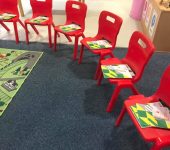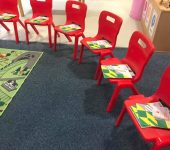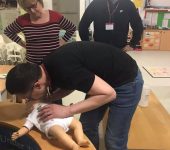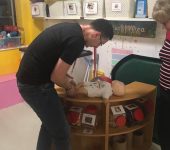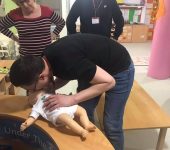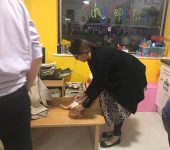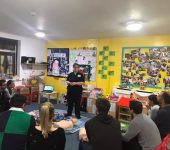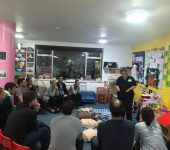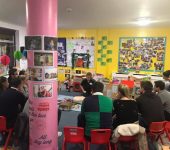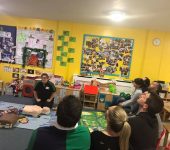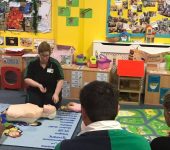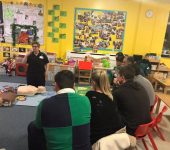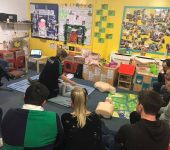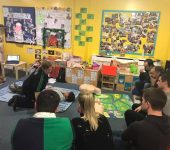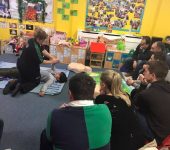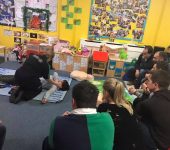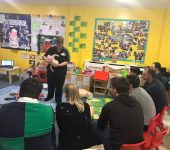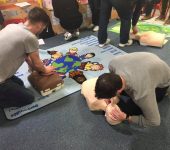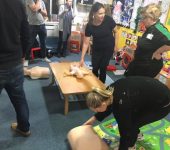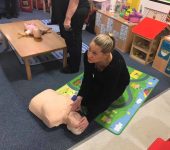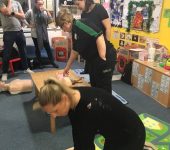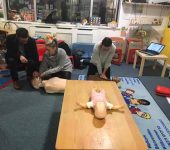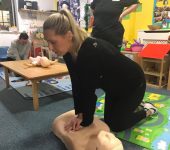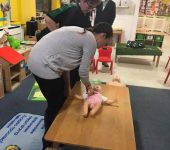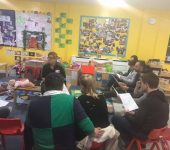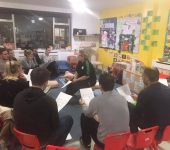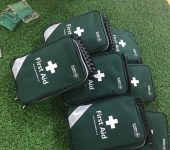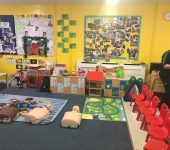First Aid
The majority of our staff at Pepperberry Day Nursery is Paediatric First Aid Trained. After three years staff has to renew their qualification in this.
We have put together the following information for parents/carers; this information is only a guide line
Breathing
If, for whatever reason, you think your child may have stopped breathing, first you must make sure that it is safe for yourself and any other child to approach. For example, if your child has had an electric shock, you will need to turn the power off before approaching. If this is not possible push the child away with a wooden object such as a broom handle or other non-conducting object. Then you should try gentle stimulation by tapping the feet or stroking your child’s neck and shouting hello or wake up. If you get no response from your child then he or she is unconscious and you must follow the ABC of resuscitation shown below. You should alsocall for help.
A – Open the airway
B – Check breathing
C – Check circulation
Mouth to mouth ventilation
Babies (under one year)
- Place your baby on a firm surface.
- Find the correct position a fingers width below the nipple line, in the middle of the chest.
- Use two fingers and press down on the chest about 1/3 of the depth of the baby’s chest.
- Press five times in about three seconds, and then blow once gently into the lungs.
- Continue for one minute.
- Take your baby to a phone and dial 999, unless someone else has already done this.
- Continue resuscitation (five compressions followed by one breath) until help arrives.
- Only if colour improves check the pulse. If present, stop chest compressions but continue to give mouth to mouth ventilation if necessary.
Children (over one year)
- Place one hand two fingers width above where the edge of the ribs meets the breastbone.
- Use the heel of that hand and press down on the chest about 1/3 of the depth of the child’s chest.
- Press five times in about three seconds, and then blow once gently into the lungs.
- Continue this process for one minute.
- Take your child to a phone and dial 999, or get someone else to call for you.
- Continue resuscitation (five compressions followed by one breath) until help arrives.
- Only if colour improves check the pulse. If present, stop chest compressions but continue to give mouth to mouth ventilation if necessary.
Recovery position
The aim of the recovery position is to keep the airway open and minimize further injury.
Babies (under one year)
- Don’t use the recovery position.
- Hold your baby on its side in your arms or your lap, in each case with the head held low.
Children (over one year)
Note: For small toddlers it may be more practical to follow the guidelines for babies. Otherwise:
- Place the arm nearest you at right angles to the body, elbow bent. Bring the other arm across the chest. Hold the hand, palm out, against the cheek.
- Roll your child on to his or her side, so that the upper leg is bent at the knee and the arms remain in the position described above.
- Tilt the head back gently to maintain the open airway.
- If in the correct position, as shown, your child will not roll on to his or her tummy or back.
- Check breathing and pulse. If either stops, follow the ABC of resuscitation.
If your child has a broken bone
- Don’t move your child if you think his or her neck or spine may be injured. Get expert help. Unnecessary movement could cause paralysis.
- A bone in your child’s leg or arm may be broken if he or she has pain and swelling, and the limb seems to be lying at a strange angle.
If you can’t easily move your child without causing pain, call an ambulance.
If you have to move your child, be very gentle. Use both hands above and below the injury to steady and support it (using blankets or clothing if necessary). Comfort your child and take him or her to hospital.
Don’t give your child anything to eat or drink after an accident. Wait until you get to the hospital. He or she may need an anesthetic later.
Minor accidents
Many general practices are equipped to deal with minor casualties such as cuts or items trapped in the nose or ear. In these sorts of cases therefore it may be more appropriate or convenient for you to seek advice from your local practice on where best to go, before attending an Accident and Emergency department.
If your child is burnt or scalded
- Immediately put the burn or scald under running cold water to reduce the heat in the skin. Do this for at least 10 minutes. If running water isn’t available, immerse the burn or scald in cold water or any other cooling fluid such as milk or other cold drinks could be used.
- Cover the burn or scald with a clean, non-fluffy cloth like a clean cotton pillow case or linen tea towel or cling film. This cuts down the danger of infection.
- If clothes are stuck to the skin, don’t try to take them off.
- Depending on the severity of the burn or scald, see your doctor or call an ambulance or take your child to hospital. You should seek medical help for anything other than a very small burn.
Don’t put butter, oil or ointment on a burn or scald. It only has to be cleaned off again before treatment can be given.
Be prepared to treat your child for shock.
If your child is choking
- Choking is caused by an obstruction in the airway and must be treated immediately.
- Look inside your child’s mouth and remove any object if it is very easy to get at. Do not probe blindly into the mouth you may push the object further in or damage the soft palate.
- If your child isn’t breathing, start mouth to mouth ventilation it may be possible to ventilate your child if the obstruction is only partial. If your child is breathing, follow the instructions below.
Babies (under one year)
- Lie the baby along your forearm or thigh with the face down and the head low and supported.
- Give up to five firm slaps between the shoulder blades.
- If this does not work, turn your baby on his or her back along your thigh head down. Give five chest thrusts using the same technique and finger position as for chest compressions, but press more sharply at a rate of about 20 per minute.
- Repeat steps 1, 2, & 3 three times.
- If this does not work, dial 999 and continue repeating the sequence of back slaps and chest thrusts.
- If your baby becomes unconscious follow the ABC of resuscitation, do not use abdominal thrusts on babies under one year.
Children (over one year)
- Encourage your child to cough if possible.
- If this doesn’t work, bend your child forwards, so that his or her head is lower than the chest, and give up to five firm slaps between the shoulder blades. Check the mouth is clear.
- If this does not work, lie your child on its back and give up to five chest thrusts using the same technique and finger position as for chest compressions but press more sharply at a rate of about 20 per minute. Check the mouth is clear.
- If this does not work, give abdominal thrusts. Place yourself behind your child and steady him or her with one arm. Put your other arm around your child, placing the heel of your hand in the upper abdomen. Give a sharp pull inwards and upwards below your child’s ribs. Repeat up to three times.
- If this does not work, summon medical aid and continue repeating the sequence of back slaps, chest thrusts, back slaps, abdominal thrusts.
- If your child becomes unconscious follow the ABC of resuscitation.
Things stuck up nose or in ears
If you suspect that your child has stuck something up his or her nose or into an ear, don’t attempt to remove it yourself (you may push it further in). Take your child to the nearest Accident and Emergency department. If the nose is blocked explain to your child that he or she will have to breathe through the mouth.
If your child has a cut
If there’s a lot of bleeding, press firmly on the wound using a pad of clean cloth. If you don’t have a cloth, use your fingers. Keep pressing until the bleeding stops. This may take 10 minutes or more.
Don’t use a tourniquet or tie anything so tightly that it stops the circulation.
If possible, raise the injured limb. This helps to stop the bleeding. But don’t do this if you think the limb is broken.
Cover the wound with a clean dressing if you can find one. If blood soaks through the pad or dressing, do not remove it. Place another pad or dressing over the top.
Then call an ambulance or take your child to hospital.
Ask your GP about a tetanus injection if your child has not been immunised.
When to take your child to hospital after an accident
- If your child is unconscious
- If your child is vomiting or drowsy
- If your child is bleeding from the ears
- If your child has stopped breathing at some stage
- If your child may have internal injuries
- If your child complains of severe pain anywhere
- If your child is having fits.
- If you’re worried or uncertain about your child’s injuries, get a doctor’s advice. If you are unsure whether you should move your child, make him or her warm and call an ambulance. Go to the Accident and Emergency department of your nearest hospital or to a local doctor, whichever is quickest. Not all hospitals have an Accident and Emergency department, so check in advance where your nearest one is. Your health visitor will be able to tell you.
If your child has taken a poison
Pills and medicines
If you’re not sure whether your child has swallowed something, spend a minute or two looking for the missing pills. Check they haven’t rolled under a chair, for example.
If you still think something has been swallowed, take your child straight away to your GP or to hospital, whichever is quickest.
Keep a close watch on your child and be prepared to follow the ABC of resuscitation if he or she becomes unconscious.
If possible, take the container (or its label) with you and a sample of whatever you think your child has swallowed.
Don’t give salt and water or do anything else to make your child sick.
Household and garden chemicals
If you think something poisonous has been swallowed, calm your child as much as you can. You’ll do this better if you can keep calm yourself. But act quickly to get your child to hospital.
If possible, take the container (or its label) with you and a sample of whatever you think has been swallowed.
If your child is in pain or there is any staining, soreness or blistering around the mouth, then he or she has probably swallowed something corrosive. Let him or her sip milk or water to ease the burning in the lips. Get your child to hospital quickly.
If your child is shocked
If pale, unwell or feeling faint after an accident, help your child to lie down.
Keep your child covered up and warm, but not too hot.
If your child has lost a lot of blood, keep his or her head down and raise your child’s legs. This makes more blood go to his or her head. But don’t do this if you suspect a head injury or a broken leg.
If your child suffocates
Quickly take away whatever is causing the suffocation.
If your child has stopped breathing, follow the ABC of resuscitation.


